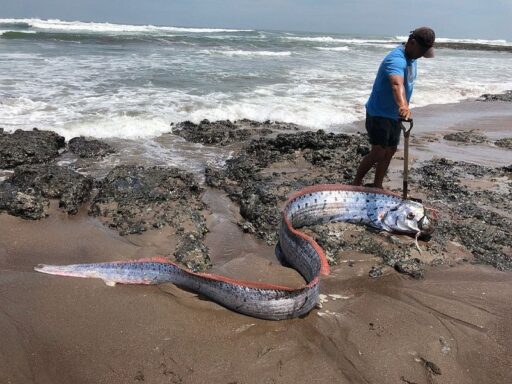- True Eels vs. Electric Eels: What's the Difference?
- The Life Stages of Eels: From Larvae to Silver Eels
- The Mystery of Eel Reproduction
- Sargasso Sea: The Breeding Ground for Eels
- Reproductive Habits of Pacific Eels
- Conger Eels and Other Non-Freshwater Eels
- Eels: Adaptations and Feeding Mechanisms
- Frequent Ask Questions About Eels Fish
- 1. Are Eels Fish?
- 2. Can Eels Reproduce in Captivity?
- 3. Why Do Eels Reproduce?
- 4. What Eels Are in the UK?
- 5. When Do Eels Die?
- 6. Where Do Eels Come From?
- 7. Which Eels Are Electric?
- 8. Who Eats Eels?
- 9. Why Do Eels Have Electricity?
- 10. Will Eels Attack Humans?
- 11. Are eels reproduced in the Bermuda Triangle?
- Conclusion
- Don't forget to read:
The serpentine bodies of eels have always intrigued marine biologists and laymen, not only because of their bodies but also due to the deep mystery surrounding their reproduction. Indeed, centuries have passed in observing the reproductive cycle of eels; as yet, scientists are still not able to unfold the mystery. Questions about their mode of reproduction, such as how do eels reproduce, how eels breed, and where eels go to reproduce, remain in question for decades. The eel has more than 800 species, all with different kinds of behaviors, and yet their reproduction remains shrouded in mystery.
In this article, we are going to enter the fascinating world of eel reproduction as we disclose the mysteries lying behind their life cycle and start an overview of scientific discoveries helping to shed light on their breeding habits.
True Eels vs. Electric Eels: What’s the Difference?
Before delving into the way the eels reproduce, a look back should be done on what a true eel is. The fishes commonly referred to as “eels” are actually not true eels. A good example of this is that the famous electric eel, Electrophorus electricus, is not an eel per se but a type of knife fish. The true eels belong to the order Anguilliformes comprising over 800 species such as moray, conger, and spaghetti eels.
Of the true eels, especially freshwater eels, Anguillids, have a very complicated life cycle involving freshwater and saltwater stages, making their journey to breed particularly interesting.
The Life Stages of Eels: From Larvae to Silver Eels
Eels represent one of the most unique cases of reproduction compared to most fishes. Distinct life stages characterize them, marked by periods of great transformations in both body and behavior. While developing and maturing, they experience five major life stages before they can breed:
- Leptocephalus Larvae: Eels begin their life in the water as tiny, transparent leptocephalus larvae. These larvae are leaves with little aquatic heads attached and perfectly camouflaged in the water. These drift through ocean currents, such as the Gulf Stream, in which they begin the long journey from birthplace to feeding grounds.
- Glass Eels: After many months or even years of drifting, the leptocephalus larvae undergo metamorphosis into glass eels. These glass eels are still transparent in form but more elongated. While at this stage of development, they begin migration toward freshwater rivers, oftentimes traveling thousands of miles.
- Yellow Eels: When they finally arrive in freshwater areas, the glass eels already have the morphology of yellow eels but with yellowish pigmentation. This could be years into their cycle, where they would dwell in rivers, lakes, or estuaries, feeding and growing.
- Silver Eels: As yellow eels mature, they metamorphose again into silver eels. These final stages of mature eels develop silvery bellies and dark dorsal areas, preparing them to start their life phase of reproduction. The silver eel is an adaptation for long-distance migration that covers the journey back to the sea for breeding.
- Sexually Mature Eels: Upon reaching their respective spawning grounds, usually in the ocean, the eels reach sexual maturity. Unlike most other fish, however, this stage remains quite a mystery as the eels become almost untraceable once they reach their breeding destinations.
The Mystery of Eel Reproduction
Centuries of research have passed, but no scientist has ever witnessed the reproduction of anguillid eels in the wild. Eel reproduction is one of nature’s greatest mysteries. The first limitation lies in the fact that sexual maturity in the eel occurs only when it returns to the sea, where it is presumed to spawn. Although scientists have indeed been able to induce sexual maturity in eels with hormone injections, natural reproduction is still unseen.
When eels reach sexual maturity, they suddenly deteriorate in health. Their bones decalcify, and their digestive systems regress, causing death following spawning. These characteristics suggest that eels probably breed only once in a lifetime before dying, another characteristic that makes the study of their reproduction even more difficult.
Sargasso Sea: The Breeding Ground for Eels
The most astonishing feature of the reproduction of eels involves their migration over long distances. Scientists have hitherto assumed that both American eels, Anguilla rostrata, and European eels, Anguilla anguilla, migrated to a strange place in the Atlantic Ocean known as the Sargasso Sea. In contrast to other seas that are enclosed by lands, the Sargasso Sea is defined by ocean currents. Scientists thus believe that these eels use the Earth’s magnetic fields to navigate during their epic migrations.

This might be as long as 4,971 miles (8,000 kilometers) for European eels, from freshwater rivers in Europe to the Sargasso Sea. Once there, they release their eggs into the water, fertilized by clouds of sperm expelled by male eels. This behavior has never been directly observed in nature, and most of what scientists know is based on inferences from indirect observations.
Reproductive Habits of Pacific Eels
While the Sargasso Sea serves as the primary spawning ground for both American and European eels, it is believed that Pacific species, including the Japanese eel Anguilla japonica, spawn north of the Mariana Islands. Other species, such as those off New Caledonia and Fiji, may spawn in Pacific-specific spawning locations. Like their Atlantic relatives, however, much about the reproductive habits of Pacific eels has not been documented.
Conger Eels and Other Non-Freshwater Eels
Less is known about the reproductive habits of non-freshwater eels, such as conger and moray eels. These species are generally in saltwater environments and are thought to spawn in deep ocean waters. A few scientists have theorized that conger eels may spawn in the Mediterranean Sea, but no scientific study has documented this behavior yet.
What is known about many of these eels, however, is that they release their eggs into the open water to be fertilized by clouds of sperm. External fertilization would be normal for many fish species, but details about locations and behaviors of the reproductive activity of non-freshwater eels have remained largely speculative.
Eels: Adaptations and Feeding Mechanisms
Although much about how eels reproduce remains unknown, the part of their physiology is pretty interesting. Some eels, like moray eels, have evolved a special set of jaws called “pharyngeal jaws” in their throats, serving them effectively in catching and eating prey. This special feeding mechanism is one of the many adaptations that make the eel such a singular creature.
Frequent Ask Questions About Eels Fish
1. Are Eels Fish?
Yes, all eels are fish and, more precisely, truly eels under the order Anguilliformes, an order that constitutes at least 800 species. While some species, like electric eels, are normally referred to as eels, they don’t comprise the true eels since they come under different fish orders. True eels include species such as moray eel, conger eel, and European eel.
2. Can Eels Reproduce in Captivity?
Eels are extremely hard to propagate in captivity. Although scientists provoked sexual maturity in eels by injections of hormones, natural breeding was never observed in captivity. These complex migration patterns and specific oceanic conditions, such as those found in the Sargasso Sea, required for their reproduction further make breeding in captivity a very rare event.
3. Why Do Eels Reproduce?
Like other living organisms, eels reproduce to advance their species. Eel reproduction ensures furtherance into the future generation. Eels mature sexually and migrate back in water before breeding and laying eggs prior to their death. Their life cycle includes one-time reproduction; this results in deteriorated health conditions culminating in eventual deaths.
4. What Eels Are in the UK?
European eel-Anguilla Anguilla is the most frequent species of eel which occurs in the UK mainland. The eels born in the Sargasso Sea migrate to European rivers and freshwater systems and return to sea when attain maturity for reproduction. European eels have become critically endangered due to factors related to the environment including over-fishing, habitat loss, and due to climatic changes.
5. When Do Eels Die?
Eels die within a short period following their reproduction. Immediately after attaining sexual maturity, the health of the eels deteriorates tremendously. The bones decalcify and the digestive system regresses while the general condition of the eel worsens considerably fast. In most instances, the eels usually die after spawning in the ocean and the event occurs once in the life cycle of the eel.
6. Where Do Eels Come From?
Eels are born in the ocean. European and American eels, for example, are thought to spawn in the Sargasso Sea in the middle of the Atlantic Ocean. They drift with ocean currents from hatching as an eel larva (leptocephalus) and are carried until they enter freshwater rivers, continuing their lifecycle. Other species, such as Japanese eels, probably spawn near the Mariana Islands or other areas in the Pacific Ocean.
7. Which Eels Are Electric?
The electric eel, though referred to commonly as an eel, is not a ‘true’ eel. It belongs to a different order of fish, known as Gymnotiformes, and is native to South America. It should be pointed out that electric eels can produce powerful electric shocks strong enough to paralyze their prey or in defense, but are not true eels belonging to the order Anguilliformes.
8. Who Eats Eels?
Eels are considered delicacies in most parts of the world. In Europe, especially in the UK and the Netherlands, dishes like jellied eels are very common. In Japan, freshwater eels, known as unagi, are considered a delicacy, generally served grilled with soy-based sauce. In addition, other smoked or stewed eels are relished as gourmet delights in other cultures. Historically, eels featured in the traditional diets of people living along coastlines.
9. Why Do Eels Have Electricity?
True eels do not possess any electricity. The name electric eel is misplaced as the electric eel is an electric the true eels lack this capability. The electric eels have certain cells, known as electrolytes, capable of storing electric charges that they release for several purposes. They use them while hunting and fighting when they can render their victims unconscious or just threatening signals to predators. None of the species that make up the order Anguilliformes possesses this ability.
10. Will Eels Attack Humans?
While all eels, in particular moray eels, may bite when feeling threatened or scared, they are hardly ever aggressive toward humans. Most of them are shy and avoid humans whenever possible. However, some species of the moray eel have pointed teeth with powerful jaws that might bite when taken from their homes. Although electric eels are a potential threat since they can yield electric shock, they are not true eels and only attack when provoked.
11. Are eels reproduced in the Bermuda Triangle?
Eels have no specific reputation for reproducing in the Bermuda Triangle, but they do reproduce in the nearby Sargasso Sea, which extends areas of that body of water across the Bermuda Triangle. Both European eels Anguilla anguilla and American eels Anguilla rostrata make their long journeys to spawn in the Sargasso Sea. While the Sargasso Sea lies within the general region of the Bermuda Triangle, eels’ reproduction is tied to this broader area, not the Bermuda Triangle itself.
Conclusion
The question of how do eels reproduce, for several centuries and after the observation scientists eluded. Since eels follow such a complicated life cycle with so many stages, their reproductive journey also has to be considered one of the most baffling phenomena in marine biology. From the early stages of leptocephalus larvae to amazing migrations either to the Sargasso Sea or the Pacific, all are filled with obscurity regarding the reproduction of eels.
Hopefully, as scientists continue to study these incredible creations, one day we will know the whole mystery of eel reproduction. Till then, the eel would remain an elusive and captivating subject in the world of marine biology.
Don’t forget to read:
Paige Spiranac Measurements, Height, Bra Size, Net Worth: All You Need to Know





